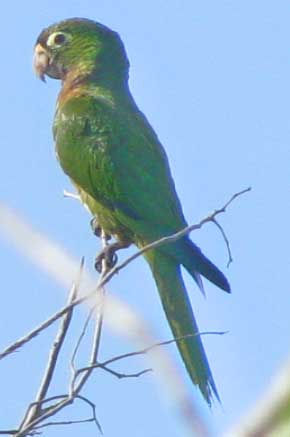Excerpts from Jim Conrad's
NATURALIST Newsletter
from the May 15, 2011 Newsletter issued from written at Mayan Beach Garden Inn 20 kms north of Mahahual; Caribbean coastal beach and mangroves, ~N18.89°, ~W87.64°; Quintana Roo state, MÉXICO
WATCHFUL PARAKEETS
 Two parakeets landed in a tree at the mangroves' edge. One began foraging lower in the bushes while the other perched higher alertly eyeing me, as shown at the right.
Two parakeets landed in a tree at the mangroves' edge. One began foraging lower in the bushes while the other perched higher alertly eyeing me, as shown at the right.
They were Aztec Parakeets, ARATINGA ASTEC, sometimes called Olive-throated Parakeets, easily recognized by their dark, olive-colored throats and chests in combination with their all-green heads. Also, here in the southeastern Yucatan Peninsula, only this one parakeet species is found.
Mexico hosts 22 members of the parrot family, which includes parrots, parakeets, macaws and a parrotlet. Of parakeets there are only seven species, and of those seven only one species occurs here, the Aztec. Remember that parrots are large with more or less squared tails, while parakeets are smaller, with slender, tapering tails. Parrotlets are like parakeets except that their pointed tails are much shorter; and you know what long-tailed, brilliantly colored macaws look like.
Aztec Parakeets are fairly flexible in their habitat preferences, occupying both evergreen and deciduous forests, semiopen areas, forest patches and even plantations. You see them in pairs, like the ones this week, or in flocks of up to fifty or more birds flying low and fast over the forest canopy.
Aztec Parakeets occur all across the Peninsula but at Hacienda Chichen in the interior I saw them only once during the year and half I was there. They're distributed from the eastern Mexican lowlands south to western Panama. They nest in arboreal termite nests, which are very common here next to the mangroves. Up at Hacienda Chichen we didn't have arboreal termite nests, so maybe that explains why Aztec Parakeets were so uncommon there.
from the September 8, 2008 Newsletter issued from Sabacché in western Yucatán, México
TERMITE NEST & AZTEC PARAKEETS
Very often when I pass the nest shown here, two Aztec [Olive-throated] Parakeets are hanging around the nest. Their presence there got me to wondering.
Parakeets are very watchful and nervous here, probably because every boy carries a slingshot, and I've known men to shoot parakeets, hoping to only wound them so they can be nursed back to health and sold. Therefore, I can't get close enough to see exactly what the parakeets are doing. However, I do clearly see them picking at the covered tunnels, and clambering over the nest itself, their heads down and their tails high as if they were chewing at the nest. They do this for extended periods of time. When they fly off the nest onto a limb they wipe their beaks as if they'd been feeding.
When I approach and the birds fly off I can see that certain tunnel sections have been ripped away, and that the nest itself has been opened in many places exposing chambers within. I can't say, however, whether the parakeets have done this. I'm not even certain whether the nest is an abandoned one or is still active.
I am sure, however that during this last week I passed the nest every morning as I went out mapping trails, and every morning the parakeets were there. I spoke with some of the older Maya in the village and they confirmed my suspicion: Those parakeets live in the termite nests, they say.
There's no reason why this shouldn't be true. Howell reports Aztec [Olive-throated] Parakeets as nesting in termitaries, and termitary is the fancy name for termite nest.
from the November 21, 2004 Newsletter issued from Komchen de Los Pájaros beside Dzemul, northwestern Yucatán, México
PARAKEETS THROUGHOUT THE DAY
It's hard to say what you might find most exotic about Komchen, but a good bet is that you'd be thrilled with the big flocks of parakeets that fly over at all hours of the day. They are Olive-throated Parakeets, ARATINGA NANA, once known as Aztec Parakeets. The species is distinguished from others by its olive-brown throat and chest.
Flocks of these birds announce themselves with their noisy, shrieking chatter as up to 30 individuals or more approach flying low over the thornforest. This species likes disturbed habitats such as forest edges, plantations and cornfields, so our hurricane-ravaged thornforest and cluster of buildings is just right for them.
A tight, fast-moving little flock dive-bombs into a tree a bit higher than the rest, suddenly the birds' screeching stops, they sit still like statues, looking around, and then slowly they begin moving. Before long they make a circus of twig-climbing and, more than anything, preening and interacting with one another.
If you ever see how social, how dependent a parakeet or parrot is on its fellow birds in the wild, what enormous pleasure they obviously find just being with their own kind, you'll always feel a bit guilty keeping a solitary bird in a cage.